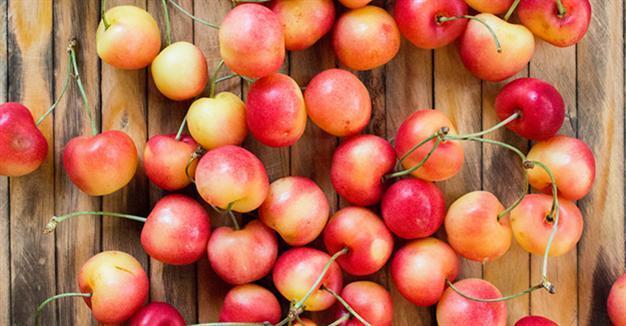Cheer with cherries!
Aylin Öney Tan - aylinoneytan@yahoo.com
 “Cherries are cold and moist. They quench thirst and lessen yellow bile and the heat of the constitution. They move the bowels. They often cause stomach ache and turn to black bile.”
“Cherries are cold and moist. They quench thirst and lessen yellow bile and the heat of the constitution. They move the bowels. They often cause stomach ache and turn to black bile.”I’ve been browsing through documents and books on Byzantine food lately; this is an excerpt from Andrew Dalby’s book, “Tastes of Byzantium, the Cuisine of a Legendary Empire.” The text continues saying the ill effects of the cherry will be prevented if one drinks austere wine of honey water, with ginger, after eating the fruit.
Byzantine cuisine was strongly dependent on food-health connections based on ancient Greek and Roman Galenic diet. Each food was believed to have certain properties like hot or cold, and moist or dry. These properties would be considered when consuming foods according to one’s health and body condition and even according to the time of the year. If we continue to trace cherries in the Byzantine diet, we see that cherries are inevitably among the food suggestions for the month of June. Here is a simple suggestion for June regarding cherries: “Among fruits, eat ‘white’ cherries and cucumbers, moderately.” This recommendation about cherries is from the text “A Dietary Calendar,” attributed to Hierophilus the Sophist, which gives information on the ruling and dominant bodily humors and the choice of food and drinks to accommodate these body humors and prescribes the appropriate fresh fruits to be consumed for each month.
Cherries are surely a delight of June, and we’re so lucky about cherries here in Turkey. In almost every corner of the country, there is a cherry festival, many of them featuring outstanding qualities and varieties of cherries. Cherries are considered native to Anatolia, particularly the city of Giresun, ancient Cerasus and Greek Kerasous, hence the Greek name for cherries: “kerasós.” There is much debate on whether the word cherry originated from the city, or the other way round, but many scholars conclude that the prominent horn-shaped silhouette of the city must have been influential in naming the place after Keras, the horn. The Turkish name for cherry, “kiraz” is a definite continuation of this heritage. According to Pliny, Roman commander Lucullus found the cherry in the Black Sea Mountains during his campaign against Mithridates, and brought this new delight to Italy from Pontus.
Of course we cannot be sure what kind of cherries adorned the festive tables of Lucullus, father of good dining, but one local white variety from Giresun is quite pale and frail, quite unappetizing in appearance, but much loved by inhabitants; apparently they were much admired also by the Byzantines. White cherries, or rather yellowish colorless cherries, are among the lesser-known types of cherries found in Turkey, but they pop up here and there. Another city that proudly features an almost translucent marble cherry statue at the entrance to town is Konya Ereğli. The market constantly seeks the red and dark varieties; perhaps this has led Turkish agriculturists to develop the “Ziraat 900” (Agriculture 900), a truly unappetizing name for a cherry! But this big dark, plump cherry is one of the most cherished cherries in the world today, with 80 percent of all produce directly exported worldwide – a huge figure as Turkey is the leading country in cherry production.
The luscious fruit adorning the feasts of Lucullus, whether pale white or deep red, must adorn June tables in all ways, just as it did throughout the centuries. It is good for you, goes the Turkish phrase, if not followed by the sweet mulberry. The cherry, being a strong detox food, would turn one as slim as its stalk, of course only if not paired with honeyed wine, as the Byzantine diet suggests!
Bite of the Week
Fork and Cork of the Week: This is more like a recipe rather than a suggestion – or a fork and cork combined into one. In a pot, put a bottle of good un-oaked red wine, preferably with dominant cherry notes, add 125 grams of sugar, peel of an orange, cinnamon stick, one or two pieces of star anise and a couple of bitter almonds or 1 teaspoon of slightly crushed mahaleb. Bring the concoction almost to the boiling point and then add 1 kg of pitted cherries. Bring to a boiling point again; as soon as it boils, remove the cherries from the pot by a slotted spoon, keeping the spices and orange peel in the pot. Place cherries in a colander set on a bowl to drain. Continue to simmer the wine until it is reduced to half or even to one third. Meanwhile add the drained juices from the cherries. Cool the syrup, and then combine with the cherries. Refrigerate a couple of hours before serving. This is a cross between compote and a drink, best enjoyed perfectly chilled at sunset, when you can add a shot of Kirsch!












